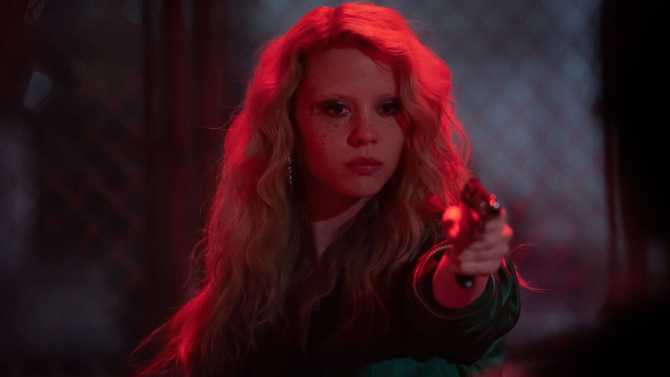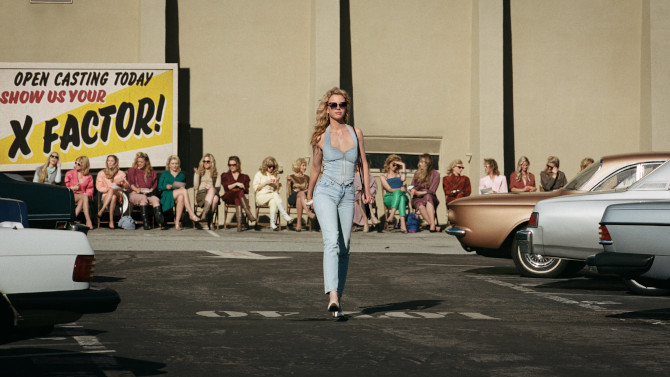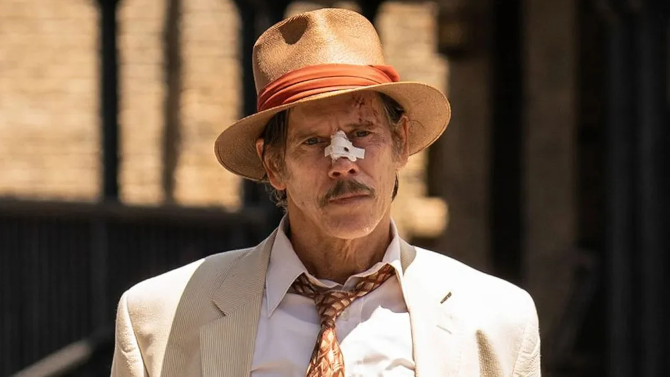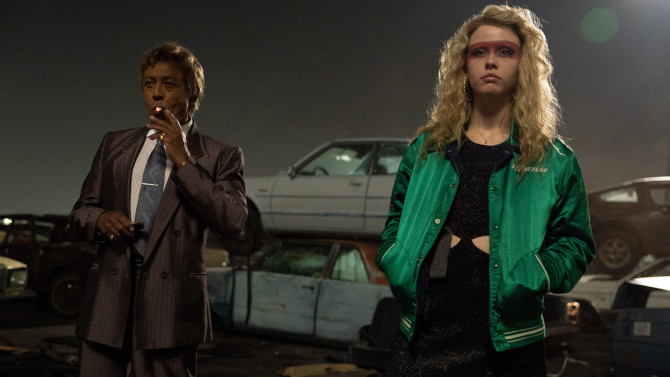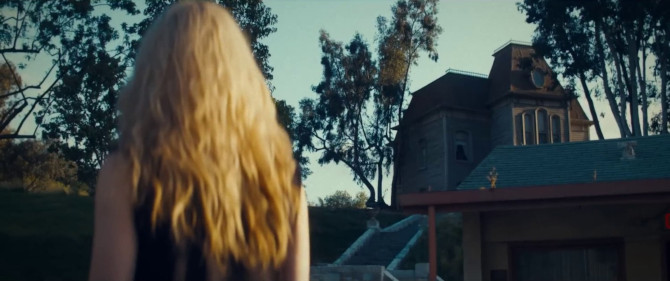It all started with X – an ode to the 1970s early slasher movies; then, it was followed up by prequel Pearl – a horror flashback paying tribute to the early days of colour cinema; and it all concludes (supposedly) with MaXXXine (2024) – which leaps into 1985. . . following survivor of the original, Maxine Minx (Mia Goth), as she navigates Los Angeles – attempting to make it in the cutthroat world of show business.
One of the more unique trilogies in cinema history, writer/director Ti West’s conclusion is not complex in its narrative. . . if you’ve been in tune with the films from the very beginning, it will likely not be too difficult to guess where it’s all leading to, but it is utterly impressive in its cinematic dialogue – in other words, how it pulls its inspiration from the history of the industry to create a striking pastiche of the 80s era.
Intriguingly, it feels as if each character is the film’s lead, no matter how much time the character is on the screen. Of course, the true star of the movie is the above mentioned Maxine. Having made it in the adult industry, she is now attempting to transition into the mainstream. Playing like a key part of Brian De Palma’s early 80s oeuvre – think Dressed to Kill, Body Double, and Blow Out – the starlet enters a seductive yet sleazily treacherous world where there is danger round every corner. West even uses some of De Palma’s trademarks, like split screen work, to add to the style of the picture.
Then, there is the mysterious villain known in the media as the Night Stalker. . . not seen until the very end, all that the audience observes is his all black attire – right down to the leather gloves. A clear tribute to the gialli of 1970s Italy, it soon becomes clear that those De Palma influences with be infused with some of the tropes found in this sub-genre (which funnily enough also influenced De Palma himself). For not only does it seem like the killer is stepping in right from this genre, but Maxine soon becomes her own amateur sleuth, attempting to stop anyone in her wake. . . including the killer, who seems to be on her tail. It is also worth noting that the score from Tyler Bates, which uses vocal manipulation and synthesizers combined with instruments, could play as a giallo score from the time.
Now you might be asking – why is Maxine attempting to do all this by herself? Well, that is because detectives Williams (Michelle Monaghan) and Torres (Bobby Cannavale) are most likely going to be useless (just like in a giallo), despite coming across as overly aggressive. As if taking umbrage with every incompetent cop ever put onscreen in the movies, they are unbelievably eager to solve the Night Stalker case and make up for all those negative cop stereotypes. We shall see.
The killer also seems to have a right hand man, a dick of a private eye, John Labat (Kevin Bacon), looking like he has just walked off of the set of the Roman Polanski neo-noir Chinatown wearing Jack Nicholson’s attire (he even has that bandaged nose). A throwback to the yesteryear of the shady gumshoe detective days, the sleazy individual is also on her trail.
There is also Teddy Knight, Esq. (Giancarlo Esposito), a lawyer and DD film agent that funnily enough could be a former partner of Breaking Bad’s Better Call Saul spinoff star. He is certainly not afraid to crush anyone in his star’s way, or as he puts it: “This guy thinks he’s the wolf, no, I’m the wolf.”
As for the other characters, they all fit into life in Hollywood circa 1985. You’ve got Elizabeth Bender (Elizabeth Debicki), a firm director (who may be casting Maxine) who is trying to make artsy B horror films in an industry looking to keep the status quo. Her star, Molly Bennett (Lily Collins), an innocent up-and-comer who rather naively likes giving Maxine advice. When Maxine isn’t working, she hangs out with video store employee and friend Leon (Moses Sumney) – a knowledgeable movie lover reminiscent of how Quentin Tarantino got his passion for film.
And, speaking of Quentin Tarantino, in many ways, this plays like a companion piece to his Once Upon a Time… in Hollywood. Cherishing bringing the past back to life, West takes us onto the sleazy streets of L.A., through the back lots of Universal Studios (it is an absolute treat that the movie is shot on the Bates Motel and Psycho house lot), into the Adult Industry (Halsey makes a cameo as a co-worker of Maxine), a premiere at Grauman’s Chinese Theatre, and even right up to the Hollywood sign itself (at least an excellent reproduction of it).
Likewise, the dialogue, visual and audio references that go along with this make for special viewing – and could fill their own review. The movie opens with a Bette Davis quote – “In this business, until you’re known as a monster, you are not a star”, to which Kim Carnes’ “Bette Davis Eyes” then appears in the film – drawing a connection between Maxine and the star. A bit later, she throws a cigarette butt upon Theda Bara’s Walk of Fame star, this suggests she’s becoming the new Vamp of Hollywood. A faux Buster Keaton then makes an appearance – he’s chosen for a reason (quite the macabre joke). A clever touch finds Psycho II referenced – which makes for a meta joke about the original film, X. Likewise, there is a lot of foreshadowing if you know your movie references. . . but I’ll leave it at that.
An intoxicating horror film for fans of the genre, MaXXXine is a fitting closing chapter to the trilogy. Worthy of several re-watches to catch all of the cinematic references, it pays fitting tribute to many a film and genre of the 70s and 80s. So, find out if you’re a horror puritan by adding the classic to the cult of people who’ve seen this movie.

